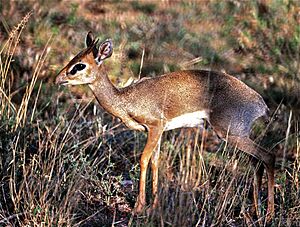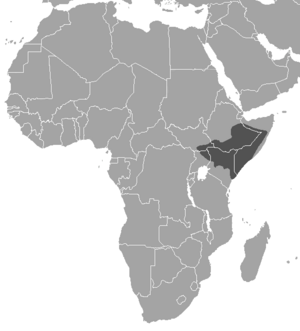Günther's dik-dik
Quick facts for kids Günther's dik-dik |
|
|---|---|
 |
|
| Günther's dik-dik at Samburu National Reserve, Kenya | |
| Conservation status | |
| Scientific classification | |
| Genus: |
Madoqua
|
| Species: |
guentheri
|
 |
|
| The range of Günther's dik-dik | |
The Günther's dik-dik (Madoqua guentheri) is a super small antelope that lives in dry areas of East Africa. Imagine a tiny deer-like animal, that's a dik-dik! They are known for their shy nature and quick movements.
Contents
What They Look Like
Günther's dik-diks are among the tiniest hoofed animals in Africa. When they are fully grown, they weigh only about 3 to 5 kilograms (6.6 to 11 pounds). That's about the same as a small house cat!
They have a coat that can be yellowish-gray or reddish-brown. Their hooves are black, and they have small heads with long necks. Their ears are quite large with white insides. The fur on their belly, chin, chest, throat, and inner thighs is a creamy white color. They also have a very short tail, only about 3 to 5 centimeters long.
Males and Females
Only the male dik-diks have horns. These horns are usually about 9.8 centimeters (3.9 inches) long, but their exact size can be different for each animal. Even though only males have horns, it can be tricky to tell males and females apart from far away. A good tip is that the females are usually a bit bigger than the males, and they don't have horns at all.
Scientists have suggested there might be four different types (subspecies) of Günther's dik-diks. These types are based on their size and fur color. However, more research is needed to confirm this using genetic tests.
Where They Live
You can find Günther's dik-diks in several countries in East Africa. They live in the lowlands of Ethiopia, and in most parts of northern and eastern Kenya. They are also found in Somalia, but not right along the coast. You might also spot them in some parts of southeastern Sudan and northeastern Uganda.
These little antelopes prefer to live in places with lots of low, bushy plants. They like thornbush areas, grassy savannas, and woodlands near rivers. They can even live in areas where the land has been changed or overgrazed by other animals. Sometimes, they share their homes with other small antelopes, like the Kirk's dik-dik.
Daily Life and Habits
Günther's dik-diks are mostly "browsers." This means they prefer to eat leaves, flowers, stems, fruits, and seeds from plants that are not grasses. Because they are so small, they mostly eat plants that grow close to the ground.
They are most active during the day. You'll often see them feeding from early morning until mid-morning, and then again from mid-afternoon until after it gets dark.
Family Life and Reproduction
Günther's dik-diks are known to be "monogamous," which means a male and female dik-dik will stay together as a pair. They don't form large family groups for very long. When a baby dik-dik (called a calf) is born, it stays with its parents for a short time. But then, the parents encourage the calf to leave and find its own way.
Female dik-diks usually give birth to only one calf at a time. They can have babies at any time of the year, not just during a specific season.
Communication
Dik-diks don't make a lot of different sounds. However, they are very good at listening to other animals. For example, if a white-bellied go-away-bird makes an alarm call, the dik-diks will react quickly. They might become more alert, looking around carefully, or even run away to stay safe.
Conservation Status
Good news! The Günther's dik-dik is currently listed as "Least Concern" by the IUCN. This means they are not considered to be in danger of disappearing. They seem to be quite common across all the areas where they live.
It's estimated that there are at least 500,000 Günther's dik-diks in the wild. People sometimes hunt them for their meat, but this is usually for local use, not for big commercial businesses. Sometimes, if dik-diks get used to being around humans, it might affect them negatively, but scientists are still studying this.


